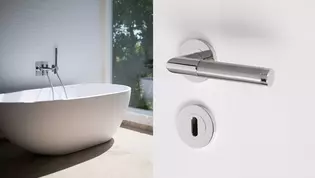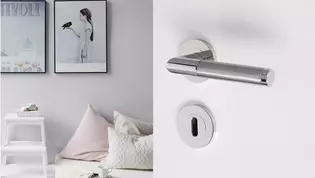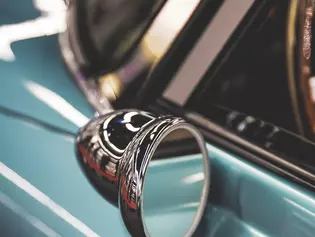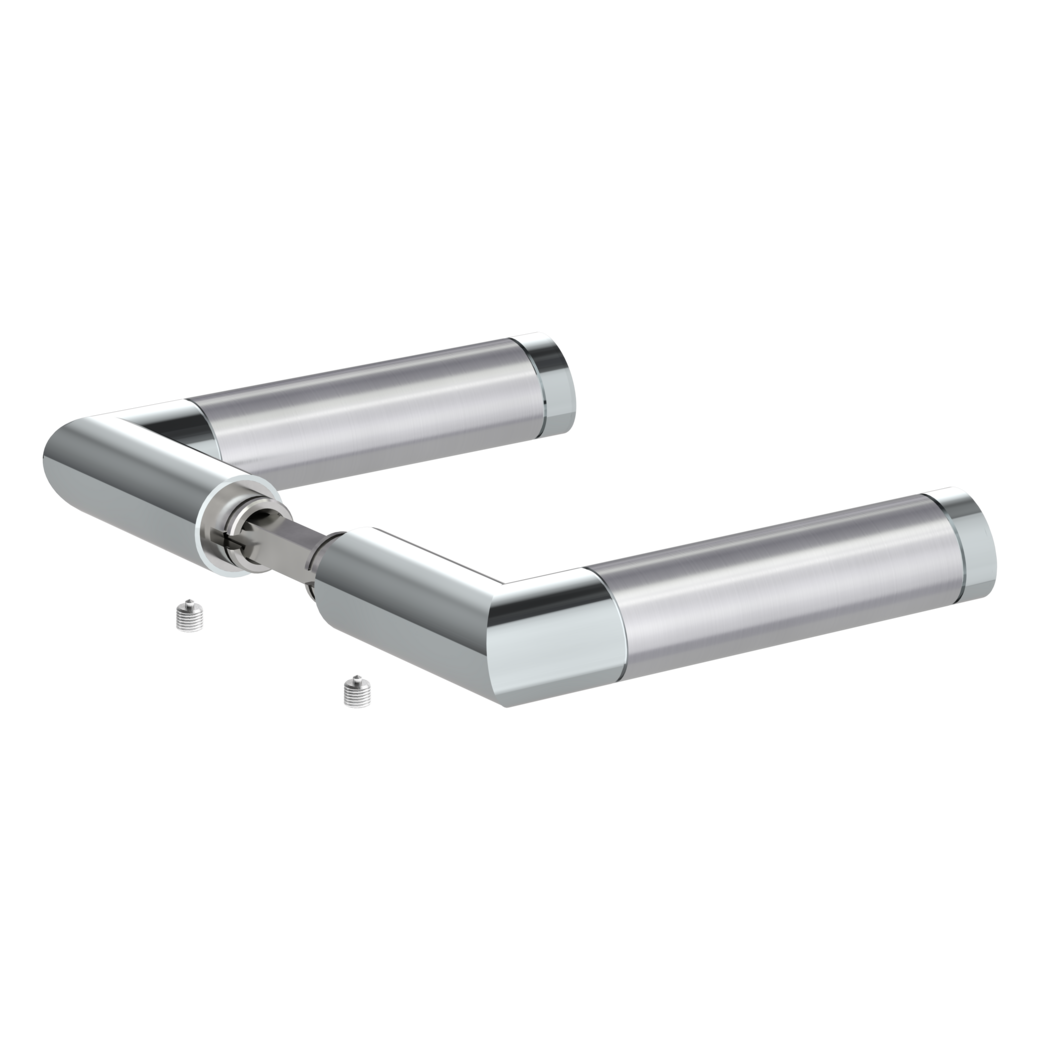Door handle setLOREDANA
Art. No. 187001073
42.67 €
MSRP (based on german VAT)*
43.03 €
MSRP (incl. VAT)*
Handle pair LOREDANA for glass door lock
Modernity meets cool elegance
Elegance and modernity characterize this door handle. The highly polished stainless steel elements reflect in a radiant shine, while the gripping surface made of matt stainless steel gently contrasts with it. A special feature is the different processing of the surfaces. Rosettes, handle neck and handle end were polished to a high gloss. Two decorative, fine lines delimit the matt gripping area. The edges of the handle end are softly rounded.

Polished stainless steel
The surface looks like chrome or powder-coated tubular steel, but is stainless steel. The high gloss is achieved by polishing. The polishing of metal is an elaborate process. The surface must be ground in several phases until it is flawlessly smooth. This type of metal finishing has a long tradition in jewelry manufacturing.
Long-lasting shine
Polished stainless steel is resistant, the shine is maintained without special care. Stainless steel is therefore particularly easy to care for and also easy to clean. Because of these properties it is also used for medical purposes. The smooth surface ensures that no germs can settle.
Planning assistance

Which doors fit Loredana?
Loredana is a real all-rounder that can be combined with modern and classic doors. The design fits to style doors as well as to reduced, simple doors. Loredana looks especially noble on white lacquer doors. The polished surfaces are a real highlight for every door and set a brilliant accent.
These living and architectural styles are suitable for Loredana
The design of the Loredana door handles harmonizes with many living and architectural styles. It always brings elegance into play. These noble door handles look perfect in combination with "Clean Chic" with a lot of white. Especially bathroom fittings and door furniture should always be coordinated. So if you have decided on chrome fittings in the bathroom, it is best to combine them with door handles in high gloss. Also nice to go with it: Design classics with elements in chrome or powder-coated tubular steel, such as the Adjustable Table by Eileen Gray (designed 1927) or the Wassiliy Chair by Marcel Breuer (designed 1925).

Operational elements such as fittings and handles should be visually coordinated.
Playing with light

Seeing is light.
The lighting effect of the furnishings characterizes the room atmosphere.
Especially in white living areas, light can unfold its full magic. Soft nuances are created.
History of living styles
Loredana is a modern interpretation of a classic, one could say. In fact, this handle design contains form quotations from two important style epochs of design history, Art Déco and Bauhaus style.
Living in Art-Déco style

The term "Art Déco" translates as "decorative arts" and first appeared in 1925 in connection with the large Parisian exhibition "Exposition Internationale des Arts Décoratifs et Industriels Modernes". The Wiener workshops are considered the forerunners of Art Deco. They were founded in 1903 by the Secession artists Josef Hoffmann and Koloman Moser.
Typical for design objects of the Art Deco style are clear, often parallel lines, layered forms, symmetries and a geometric simplification of ornaments and shapes. Tastelessness was not in demand. Shapely elegance was aimed for. Everything should have "class".
The preceding industrialization at the beginning of the century had rigorously given priority to what could be produced by machine. Objective pragmatism prevailed. With Art Déco, the artistic, the decorative returned. Frequently used materials were chrome, but also fine woods and polished stone such as marble. Exotic and luxurious attributes were popular. Anyone who wants to take a trip back to this time will think of the glamorous furnishings of the Titanic or of illustrious societies that celebrated their prosperity in the film "The Great Gatsby". The Golden 20's were full of glamour and glamour, it was allowed to be opulent but never degenerated to tastelessness. People liked to be a bit undercooled, not to say distanced. The dandy look belongs to this epoch, but also a new androgynous, sporty image of women. The hair was worn short. The typical "bubble head" was born. One presented oneself in self-confident, elegant poses.
Nostalgia resonates when you look at the Loredana door handle design. The elegance and dynamics of the lines are reminiscent of decorative chrome elements of shapely classic cars. Whether bumper, brand emblem or mirror shining elements completed the form and gave impressive value and unique aura. Cool chrome is a beautiful contrast to colored areas, which should not be too intense, however.

Living in Bauhaus style
Modernity and no-frills practicality make up the timeless, yet sophisticated aesthetics of this style. He was influenced by the State Bauhaus, the art school founded by Walter Gropius in 1919. Geometric basic bodies formed the typical canon of forms. Products should also meet the requirements of the new modernism. This included high functionality, but also industrial producibility in large quantities. For the typical Bauhaus handle by Walter Gropius, therefore, semi-finished products such as drawn tubes were used. The design of the Loredana door handle is also formed by cylindrical basic bodies. The handle neck and the handle are connected by a right angle.
Polished, high-gloss metal, chrome and powder-coated tubular steel can be found in many design classics of the Bauhaus style such as the MTBK 24 teapot by Marianne Brandt. The use of round tube was also very popular. A round tube construction made it possible to build the cantilever chairs by Marcel Breuer.


Clear lines, right angles and lots of white: in this ambience, the cool elegance of LOREDANA comes into its own.
Loredana: Origin from Italy
Loredana means translated "the laurel wreath", "the laurel" or "the end of the laurel" and has a Latin origin. It is believed that the name comes from Venice and is derived from the surname Loredan and the town of Loreo.
The history of the GRIFFWERK GmbH also began in Italy, more precisely in the northern Italian town of Lavenone, a community with almost 600 inhabitants. The hardware manufacturer Frascio is located there. The first door handle portfolio was created in cooperation with the Frascio company. Many Italian designs belonged to it and quite a few of the handles bore sonorous Italian names, such as LOREDANA.


